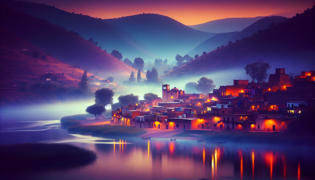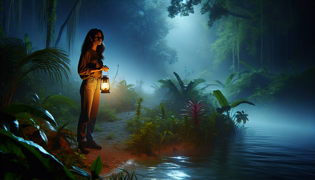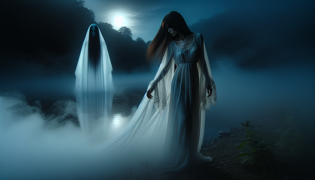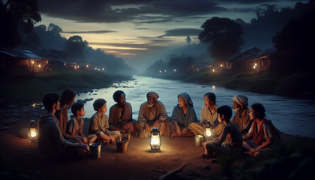La Llorona
Reading Time: 5 min

About Story: La Llorona is a Legend from colombia set in the 20th Century. This Descriptive tale explores themes of Loss and is suitable for Adults. It offers Cultural insights. A poignant encounter with a sorrowful spirit by the Río Grande.
In the quiet town of San Agustín, where the whispers of the past lingered like the morning mist over the Río Grande, an eerie stillness often settled as dusk approached. The river, a lifeline for the villagers, mirrored the fading light, its waters shimmering with the hues of orange and purple. Children played along its banks during the day, their laughter echoing against the surrounding hills. But as nightfall descended, an unsettling silence took hold, and the river's gentle flow seemed to carry secrets that only the darkness could conceal. It was during these twilight hours that the townsfolk spoke of a sorrowful presence, a spectral figure that wandered the water's edge, her mournful cries piercing the night.
The village of San Agustín was nestled between rolling hills and the expansive Río Grande, a place where tradition and folklore were woven into the very fabric of daily life. The landscape was a tapestry of vibrant greenery, dotted with vibrant wildflowers that swayed gently in the breeze. The river itself was both a giver and taker, providing sustenance and beauty, yet holding an undercurrent of mystery that the villagers rarely spoke of openly. The houses, constructed from adobe and adorned with colorful tiles, stood as a testament to generations that had called this place home. As the sun set, casting long shadows over the land, an air of anticipation settled over the town, for the stories of old were never far from anyone's mind.

Maria Elena, a young woman of seventeen, had grown up hearing tales of the weeping woman who haunted the riverbanks. Her grandmother would often recount the legend of La Llorona, a heartbroken spirit searching for her lost children, lost to the very waters that sustained their community. Maria Elena dismissed these stories as mere folklore, a way to explain the inexplicable and to keep children from wandering too far. Yet, as she stood by the river that evening, the sight of the moon's reflection dancing on the surface stirred a sense of unease within her. The air was thick with humidity, and the crickets' song provided a constant backdrop to the night's unfolding drama. Little did she know, her skepticism would soon be challenged by events that defied rational explanation.

As the night deepened, a thick fog began to roll in from the river, enveloping the village in a shroud of gray. The familiar sounds of nocturnal creatures seemed muffled, as if the fog absorbed all sound. Maria Elena decided to take a walk along the riverbank, seeking solace in the familiar path that had been her companion since childhood. The path was lined with ancient trees whose branches swayed gently, creating a rustling sound that blended with the distant hum of the night. Her footsteps echoed softly against the earthen trail, creating a rhythm that matched her contemplative mood. Suddenly, a chilling sound pierced the night—the distant wail of a woman crying, sorrowful and haunting. Maria's heart quickened, her breath visible in the cool air as she strained to locate the source of the lament.

Compelled by a mixture of fear and curiosity, Maria Elena followed the sound, her lantern casting a faint glow on the mist-covered ground. The cries led her deeper into the heart of the woods that bordered the river, where the trees grew denser and the path less defined. The further she ventured, the more intense the wailing became, as if the spirit's anguish was growing louder with each step. Suddenly, through the fog, a figure emerged—a woman dressed in white, her long dark hair cascading over her face, obscuring her features. Her eyes, visible beneath the strands, were hollow and filled with an eternal sorrow. Maria Elena froze, unable to tear her gaze away from the spectral apparition who floated near the water's edge, her hands reaching out as if trying to grasp something just beyond sight.

As moments stretched into an eternity, the ghostly woman began to move towards the river, her movements graceful yet burdened by an invisible weight. Maria Elena felt a pull in her heart, a connection to the spirit's pain that transcended the physical realm. She stepped closer, the lantern's light flickering as if reflecting the turmoil within her. The woman's cries turned into soft whispers, a tale of love and loss that had been etched into the very essence of her being. Maria Elena listened, her skepticism dissolving under the weight of the spirit's sorrow. The story unfolded—a mother’s impossible grief, a tragedy that led to her eternal wandering, forever searching for what was irretrievably lost. As dawn's first light began to pierce the fog, the apparition slowly dissipated, leaving Maria Elena standing alone by the river, forever changed by the encounter.

In the days that followed, Maria Elena found herself haunted not by fear, but by empathy. She delved into the village's archives, uncovering the true story behind La Llorona. Centuries ago, tragedy had struck San Agustín when a mother, overwhelmed by despair, had lost her children to the very river they adored. Her grief had been so profound that her spirit could not rest, forever wandering the shores in search of her lost ones. Maria Elena realized that the legend was not just a tale to scare children, but a poignant reminder of the depths of a mother's love and the devastating power of loss. Determined to honor the spirit's memory, she organized a community gathering by the river, where stories were shared, and memories were celebrated. The townsfolk, once wary of the old legends, joined together in solidarity, finding comfort in each other's presence and in the shared history that bound them. As they came together under the twilight sky, the presence of La Llorona felt less like a haunting and more like a guardian watching over them, ensuring that the lessons of the past were never forgotten.


















